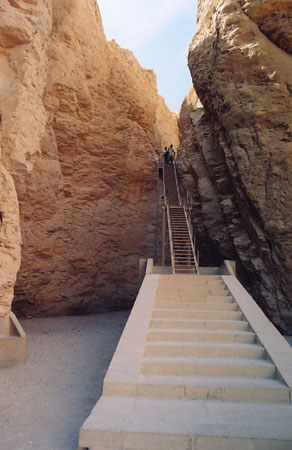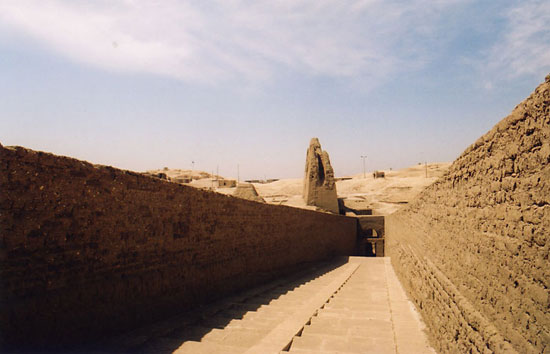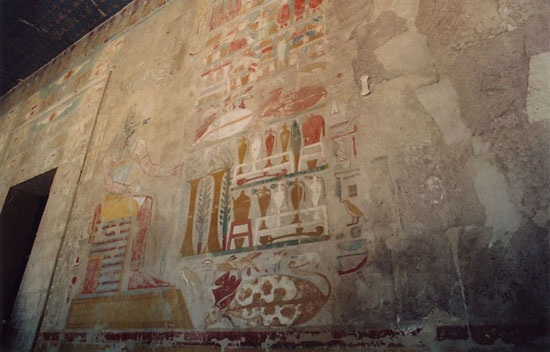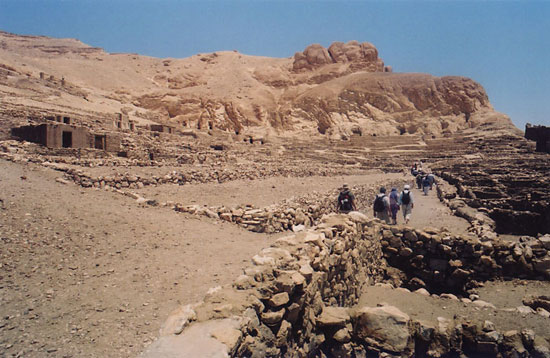West Bank
So this is how I worked my personal tour of the West Bank. After taking the ferry from the pier across from the Luxor Temple (1EP each way for a decidedly local style of transport), I was dogged by touts until I practically had a breakdown. I may have scared them into submission—no one likes publicly hysterical women! One tout agreed to have his driver take me to three sites of my choosing for 25EP, a bargain price, but made sure to lean in through the window before we took off and loudly tell me, "Don't forget to give him baksheesh!" Like it's so easy to forget.
I cover what ended up being a wonderful day spent with Mahmoud, my driver, in another entry, so here I will just discuss the actual sites visited. While idling in the car outside the ticket office, I flipped through my guidebook and considered Alaa's recommendations. I chose the Valley of the Kings, as everyone does; the temple of Hatshepsut; and the workman's village at Deir El-Medina. I had heard raves about the Tomb of Nefertari, but it, unfortunately, was not open. I bought my tickets for Deir El-Medina and Hatshepsut at the main ticket office, each 12EP or 6EP for students.
 |
| Tuthmosis III's tomb |
Tuthmosis III's tomb is one of the oldest and most inaccessible. It was up a steep staircase, then down another steep staircase into a hot humid tomb decorated with unusual stick-figure paintings (very early style). You are not allowed to photograph the tombs at all, but I know from tombs I saw later that if you're alone, the guards will actually encourage you to photograph the paintings WITH flash if it means they'll get baksheesh for allowing it. Please don't do this!
Going to Ramses I's tomb was a poor choice. It actually wasn't my intention—Ramses III's tomb sounded much better and appeared more popular from seeing tourists climbing up the path. But we were thrown by the signs, since a second Ramses tomb was at the same hill, underneath it rather than above, and ended up in the wrong one. Ramses I's tomb is very small and simple, and when you're limited to three tombs, it's not worthwhile. It is so small that the ticket takers hold you at the door until there is room for you to enter.
 Merenptah's tomb was a nice one, and hey, handicap-accessible. It's a long ramp down with reliefs of Isis lining the walls along the way. There are a few giant granite sarcophagi inside and more hieroglyphics. It was very impressive for its sheer size, with more chambers than the other tombs we visited.
Merenptah's tomb was a nice one, and hey, handicap-accessible. It's a long ramp down with reliefs of Isis lining the walls along the way. There are a few giant granite sarcophagi inside and more hieroglyphics. It was very impressive for its sheer size, with more chambers than the other tombs we visited.
 |
| Paintings on Hatshepsut's temple |
The setting is amazing with the temple carved into the cliff side. Looking more like a modern municipal building from far away, the temple has a plain, wide façade. You walk up a long ramp to the entrance, where the simple colonnade is studded with statues. For a temple exposed to the elements, the paintings at Hatshepsut have decent color. It is definitely recommended. I spent an hour here.
 |
| Hatshepsut's Temple |
It is very difficult to escape the requests for baksheesh here, which may be more desperate because of the lack of visitors. I truly didn't have extra change with me at this point beyond what I had planned to give at the tombs, so I firmly refused to take any guidance or hear any advice. The guards swore they did not want my money and only wanted to help. After they "helped" and held their hands out in supplication, I stuck to my guns and refused to give any money.

I visited the worker's tombs after the temple. They are STUNNING. They are very small and in excellent condition, with deep, rich colors and clear depictions of village life. You are required to go with a guide, who unfortunately is not that helpful. I think the group of guards waiting around flips a coin to see whose turn it is to play with the tourists. The chosen guard then leads the way and points randomly saying the same things over and over, "Wife, wife, wife, wife, vegetables, vegetables, digging, digging, digging." Yes, my guide earned his 2EP. But the paintings were beautiful, and I highly recommend a visit to the workmen's village, if only to see these two small tombs. I spent 90 minutes here, mostly walking around the area.
I am glad I didn't go to the Valley of the Queens in addition—the tombs begin to blend together for those of use who are not students of history. It was a long, hot day, and I was ready for the best part: meeting Mahmoud's family. Read on.